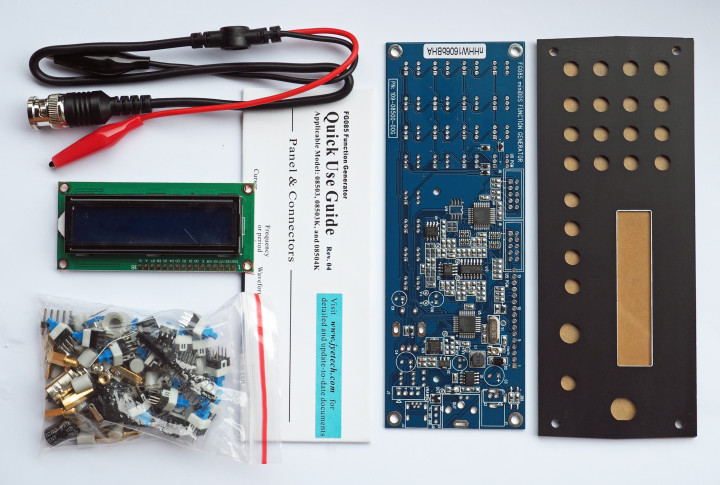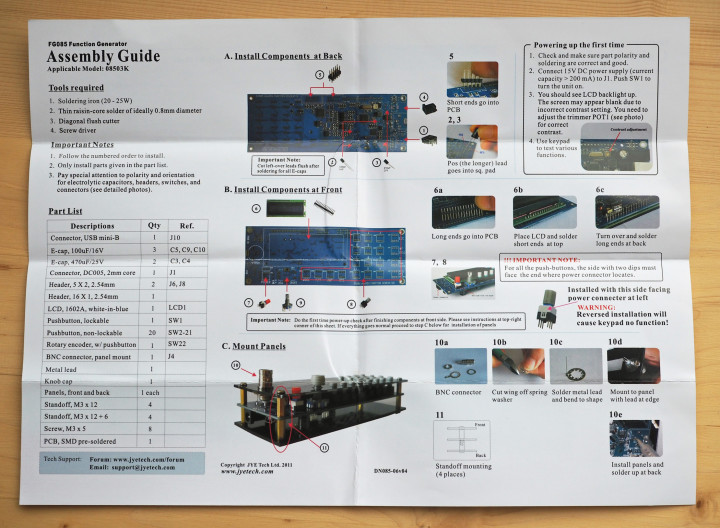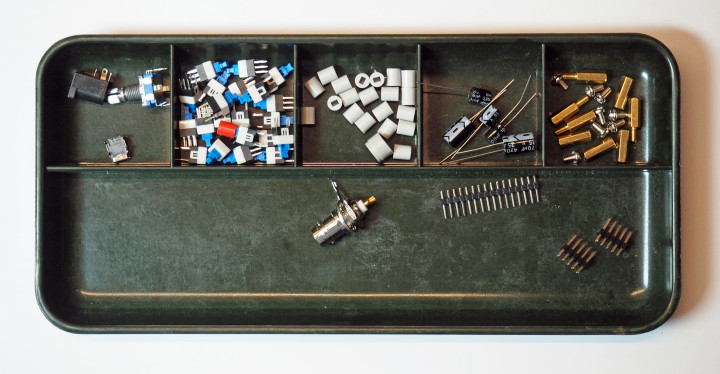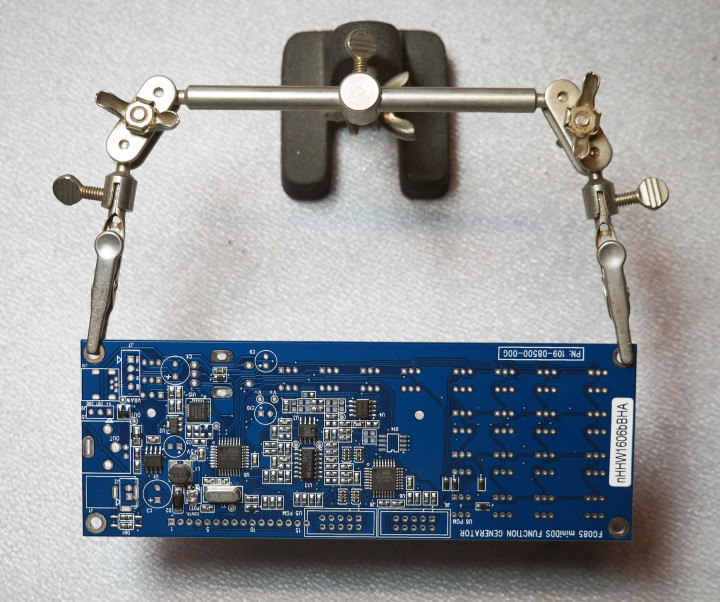Review: FG085 function generator kit
August 18, 2016
on
on

At the time Elektor introduced this little generator I happened to be considering designing a function generator myself. I was thinking along the lines of a simple device using a 555 on a breadboard or alternatively a microcontroller powered generator. This kit however caught my eye; it’s low-cost and involves a small amount of assembly but would seem to be the quickest way to build exactly what I need.
Next to multimeters , DC power supplies and an oscilloscope, the function generator is really the last piece of essential kit to complete the small electronics workshop or maker-space setup. For general purpose applications the function generator does not need to be too sophisticated to still be extremely useful. A modern generator powered by a microprocessor achieves much better performance than older designs which typically used the analog XR2206 generator chip (see this Elektor article of 1978). The FG085 function generator kit uses Direct Digital Synthesis (DDS) techniques to produce a continuous output signal with a frequency in the range of 1 to 200,000 Hz and with a choice of seven different types of output waveform including sine, square, triangle, sawtooth and staircase as well as a user-defined arbitrary waveform. This should cover the vast majority of applications. All this at a cost of around less than 50 Euros is really impressive.

This is what you get for your money: A cable with a BNC plug at one end with two croc-clips at the other, an LCD module, a bag of components, a "Quick User Guide", a partially assembled board with all the tricky SMDs components already fitted, a black plastic front panel (already labeled and shown from behind here) and a backplate.

The guide includes assembly instructions. At first sight they may seem a bit skimpy but it’s well illustrated and perfectly adequate for the job. The only point I would disagree on is the recommended power rating of the soldering iron. Some of the joints you need to make are connected with the ground plane on either side of the board, you need to heat the area up quickly to avoid damaging components so I would advise something like a 50 W iron minimum. My 90 W soldering station did the job well, there are not too many capacitors but quite a few pushbuttons to fit.

I sorted the bag of components into a tray so I could see if anything was missing. Luckily everything was included. In addition to the components, pushbuttons, USB and BNC connector were also spacers and screws.

If you take a close look at the partially assembled board you can appreciate how difficult it would have been to mount the SMDs yourself. Even the capacitors and resistors are significantly smaller than a 1206 outline which are relatively simple to mount by hand. In all there 5 capacitors, 2 jacks, 3 pinheaders, 1 rotary encoder and 21 pushbuttons with 6 solder pins to solder. First of all: The PCB is assembled using environmentally friendly lead-free solder but for the manual soldering traditional leaded solder makes a neater job. I did try using lead-free but ended up reverting to the old technology. The ROHS directive ultimately applies to producers and not for individuals.
Next to multimeters , DC power supplies and an oscilloscope, the function generator is really the last piece of essential kit to complete the small electronics workshop or maker-space setup. For general purpose applications the function generator does not need to be too sophisticated to still be extremely useful. A modern generator powered by a microprocessor achieves much better performance than older designs which typically used the analog XR2206 generator chip (see this Elektor article of 1978). The FG085 function generator kit uses Direct Digital Synthesis (DDS) techniques to produce a continuous output signal with a frequency in the range of 1 to 200,000 Hz and with a choice of seven different types of output waveform including sine, square, triangle, sawtooth and staircase as well as a user-defined arbitrary waveform. This should cover the vast majority of applications. All this at a cost of around less than 50 Euros is really impressive.

This is what you get for your money: A cable with a BNC plug at one end with two croc-clips at the other, an LCD module, a bag of components, a "Quick User Guide", a partially assembled board with all the tricky SMDs components already fitted, a black plastic front panel (already labeled and shown from behind here) and a backplate.

The guide includes assembly instructions. At first sight they may seem a bit skimpy but it’s well illustrated and perfectly adequate for the job. The only point I would disagree on is the recommended power rating of the soldering iron. Some of the joints you need to make are connected with the ground plane on either side of the board, you need to heat the area up quickly to avoid damaging components so I would advise something like a 50 W iron minimum. My 90 W soldering station did the job well, there are not too many capacitors but quite a few pushbuttons to fit.

I sorted the bag of components into a tray so I could see if anything was missing. Luckily everything was included. In addition to the components, pushbuttons, USB and BNC connector were also spacers and screws.

If you take a close look at the partially assembled board you can appreciate how difficult it would have been to mount the SMDs yourself. Even the capacitors and resistors are significantly smaller than a 1206 outline which are relatively simple to mount by hand. In all there 5 capacitors, 2 jacks, 3 pinheaders, 1 rotary encoder and 21 pushbuttons with 6 solder pins to solder. First of all: The PCB is assembled using environmentally friendly lead-free solder but for the manual soldering traditional leaded solder makes a neater job. I did try using lead-free but ended up reverting to the old technology. The ROHS directive ultimately applies to producers and not for individuals.
Read full article
Hide full article


Discussion (0 comments)